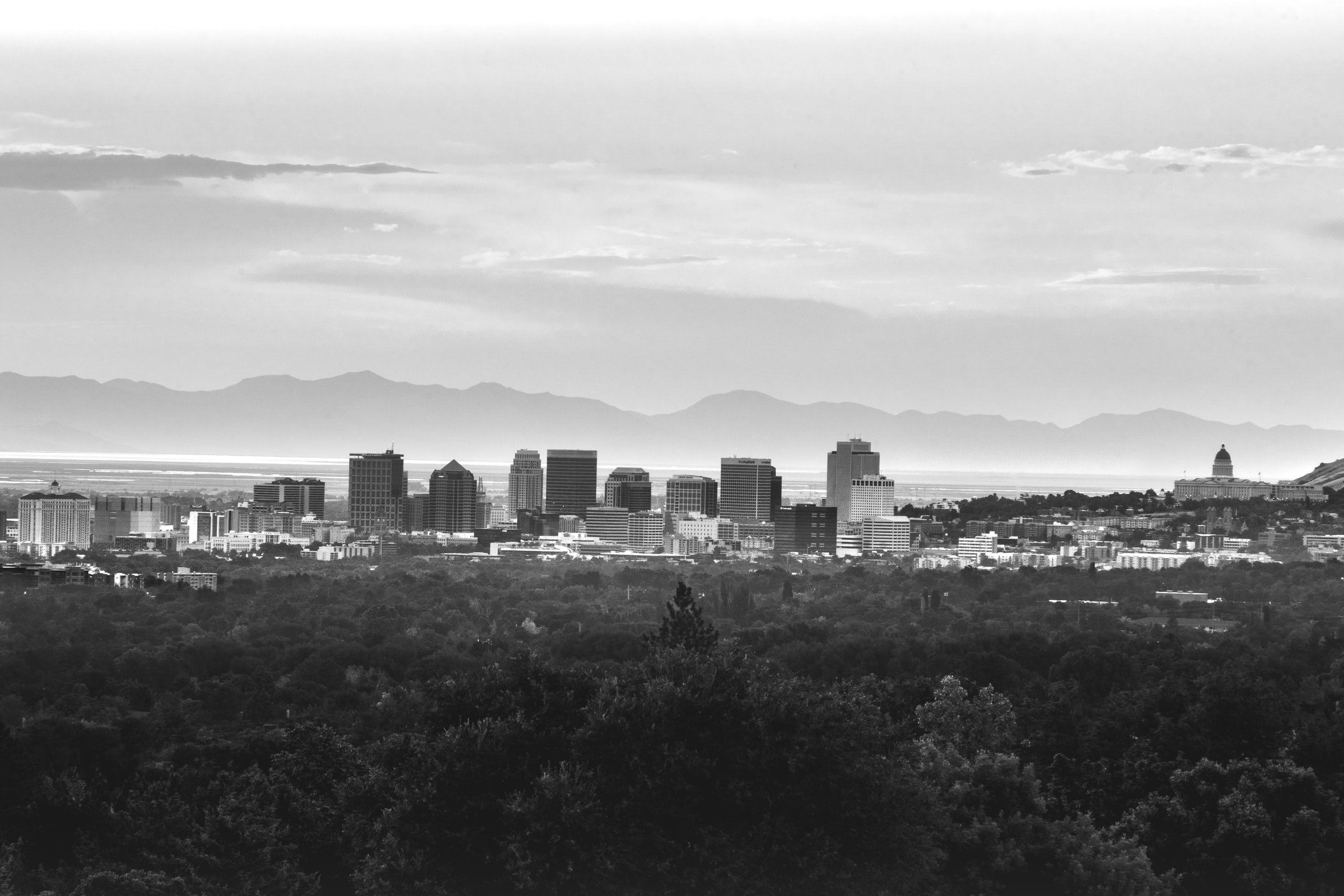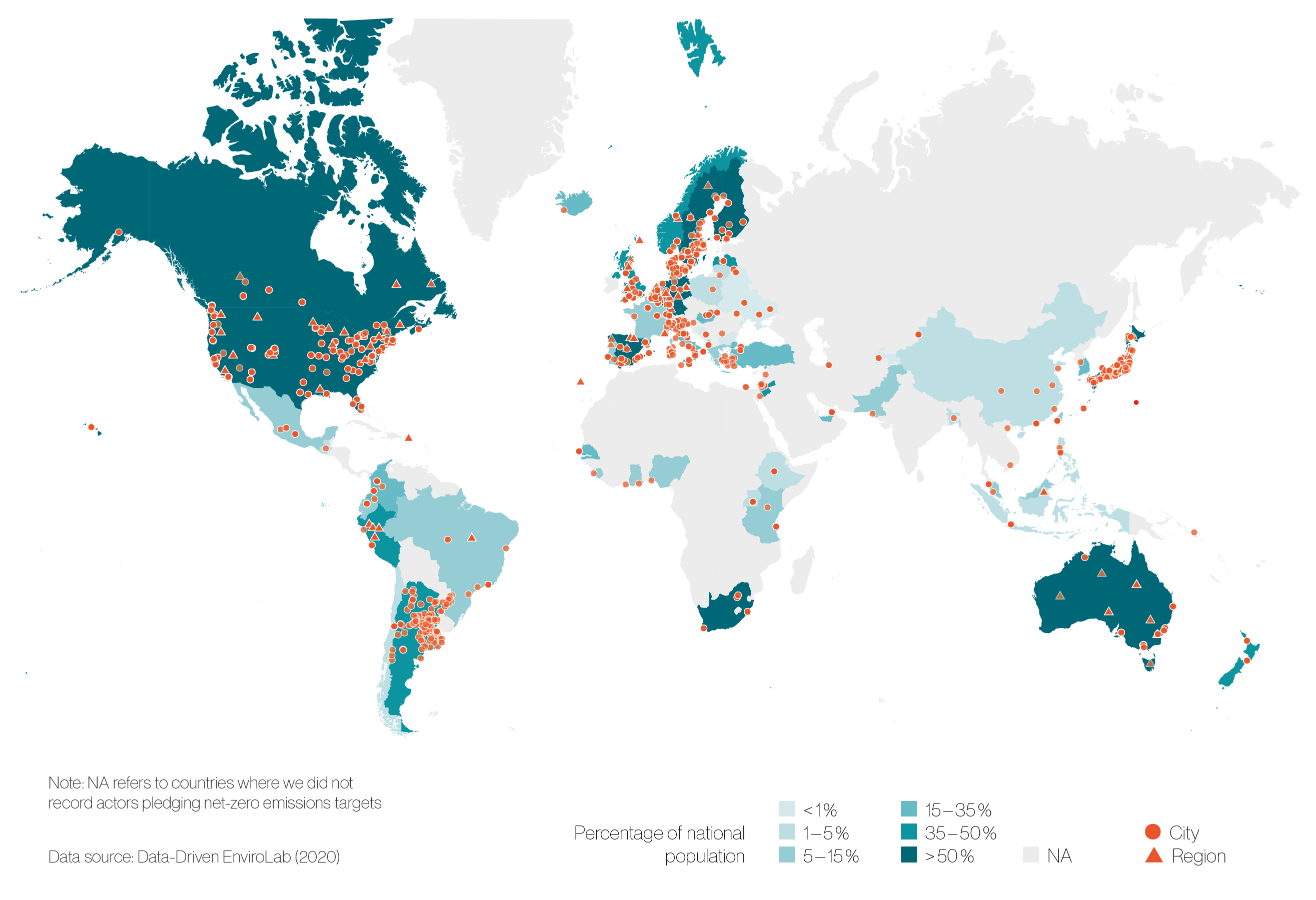
Photo: Unsplash
September 21, 2020 — Cities, regions and companies are pledging to net-zero emissions on a growing scale, taking important steps towards keeping the Paris Agreement within reach. The number of local governments and businesses committing to a net-zero emissions target by the end of the century has grown since late 2019, according to a new analysis from Data-Driven EnviroLab and NewClimate Institute.
As of September 2020, more than 800 cities, 100 regions, and 1,500 companies have joined a global effort to decarbonize their societies and economies, according to a review of nine of the world’s largest climate action reporting platforms, such as CDP and the UN’s Global Climate Action Portal. Over the past year, participation among regional governments such as Wallonia in Belgium or California in the United States increased nine-fold, with an additional 90 regions in 2020 joining the 11 regions recorded in 2019. Cities making net-zero pledges grew seven-fold, with 700 cities adding to the 100 recorded in 2019, and companies making net-zero pledges tripled, from around 500 cities recording net-zero pledges in 2010 to 1,500 recorded in 2020.
These city and regional governments represent over 846 million people, 11 percent of the global population, and have a greenhouse gas emissions footprint of 6.5 gigatonnes of carbon dioxide equivalent, larger than the United States’ annual greenhouse gas emissions.1World Resources Institute. (2020). Historical GHG Emissions (CAIT data, 2016). ClimateWatch. World Resources Institute, Washington, D.C. https://www.climatewatchdata.org/ghg-emissions?end_ year=2018®ions=TOP% 2CEUU%2CNAR%2COECD%2CWORLD%2CGBR%2CCHN%2CDEU%2CIDN %2CJPN%2CZAF%2CUSA&source=GCP&start_year=1960 (accessed September 2020). The 1,500 participating companies represent a combined revenue of more than $11.4 trillion USD — an amount on par with roughly half of the U.S. GDP.2The World Bank. (2020b). GDP (Current US$). https://data.worldbank.org/indicator/NY.GDP.MKTP.CD?most_ recent_value_desc=true (accessed September 14, 2020) Their 3.5 gigatonne greenhouse gas emissions footprint is larger than the European Union’s annual emissions.3World Resources Institute. (2020). Historical GHG Emissions (CAIT data, 2016). ClimateWatch. World Resources Institute, Washington, D.C. https://www.climatewatchdata.org/ghg-emissions?end_ year=2018®ions=TOP% 2CEUU%2CNAR%2COECD%2CWORLD%2CGBR%2CCHN%2CDEU%2CIDN %2CJPN%2CZAF%2CUSA&source=GCP&start_year=1960 (accessed September 2020).
Given their scale, their efforts could add much-needed momentum to the Paris Agreement’s goal of reaching net-zero emissions by 2050. In a net-zero scenario, transformations across the energy, building, transportation, infrastructure, and industrial sectors reduce greenhouse gas emissions as much as possible. Any remaining emissions are absorbed by natural sinks, fostered by natural solutions, such as reforestation and smart agriculture, or technological solutions like carbon capture and storage.
“While more than 120 national governments have set or promised to set net-zero goals, the pace of change still falls short of what’s needed to achieve net-zero emissions by 2050, and avoid the most dire impacts of climate change,” said Angel Hsu, Assistant Professor at Yale-NUS College and the Director of the Data-Driven EnviroLab. “City, region, and company commitments can spur national governments to act more quickly and ambitiously. They also play a vital role in achieving the unprecedented transformations needed to shift the world over to a net-zero trajectory.”
Local governments and companies’ net-zero efforts range from actors that have created a roadmap to completely decarbonize their government or company, to broader announcements and promises. Some commitments include an actor’s entire emissions footprint, while others hone in on specific sectors, such as energy, transport, or buildings. The analysis identifies where momentum is building, and where more mobilization may be needed:
- Momentum among cities and regions spans most geographic areas, and participation in net-zero efforts are especially strong in:
- The East Asia and Pacific region, with over 160 cities and more than 30 regions representing over 223 million people, over 10 percent of the region’s total population. These include eight of Australia’s states, such as New South Wales (8 million) and Victoria (6.3 million), and 135 cities and 22 regions in Japan (combined population of 97 million), most of which are a member of the 2050 Zero Carbon Cities in Japan initiative.
- North America, with 27 regions and 121 cities encompassing over 220 million people, an amount equal to about 60 percent of this region’s total population. These include nearly half of all U.S. states — 24 in total4Includes Puerto Rico and Washington, D.C. — from California and New York to Pennsylvania, Nevada and Louisiana, aiming to achieve net-zero emissions across their entire economy or within key sectors such as renewable energy.
- Europe, with more than 290 cities and over 35 regions, representing more than 162 million people, more than 36% of the E.U.’s total population. These include some of the actors setting the earliest net-zero targets. Copenhagen, for instance, aims to become the first carbon neutral capital by 2025, while Turku, Finland has pledged to become carbon neutral by 2029, and a “climate positive city,” with negative net emissions, after that year.

Geographical coverage of cities and regions pledging towards net zero.
- Companies across a wide range of sectors have made net-zero commitments:
- The consumer discretionary sector leads the way, with 195 companies aiming for net-zero. This sector also makes up the largest share of the total revenue, representing a combined $2 trillion USD from 195 companies employing 3.9 million people.5Among the companies with available sector or revenue data.
- Industrials are the next most active sector, with 171 companies aiming for net-zero, encompassing over $1 trillion USD in revenue and over 3 million employees.6Among the companies with available sector or revenue data.
Companies in sectors traditionally considered difficult to decarbonize are also setting ambitious targets. Some businesses are aiming for net-zero in the next few years, and others are going beyond their direct emission scopes, targeting supply-chain and downstream scope 3 emissions.
Many initiatives of like-minded companies, cities, and regions have helped propel this growth in net-zero efforts. The Race to Zero campaign has mobilized initiatives that include 1,128 companies, 452 cities, and 22 regions, along with 45 investors and 549 universities, working towards achieving net-zero CO2 emissions by 2050.
The report, funded by the IKEA Foundation and developed in partnership with the UNFCCC’s High-Level Champions for Chile and UK, also finds that the content of net-zero commitments varies widely; despite similar terminology, two net-zero commitments often outline very different goals. Some companies make net-zero commitments focused on targeted locations or products, while others outline plans to decarbonize their entire business model. Some rely heavily on offsets to neutralize their annual emissions, while others explicitly note a commitment to use offsets only in the event that emissions cannot be directly reduced.
Among local governments, roughly 43 percent of cities and regions have released action plans outlining how they will achieve their net-zero targets, and approximately 30 percent have incorporated their net-zero targets into policies and legislation. Many net-zero commitments have been made relatively recently, in the past few years, and actors also frequently reported that they expect to develop plans or pass legislation over the coming year.
“As with any climate action commitment, understanding exactly what’s being pledged — and how it will be achieved — is crucial to determining its effect on national and global greenhouse gas emissions,” said Thomas Day of NewClimate Institute. “We’ll be releasing a follow-up report later this fall that dives deeper into the nuances of what these pledges promise and how actors can contribute to the global decarbonisation challenge in the most transparent and constructive way.”
Read the report here: Accelerating Net Zero: Exploring Cities, Regions, and Companies’ Pledges to Decarbonise
Contact:
Elwin Lim, Research Assistant, Data-Driven EnviroLab: elwin.lim@u.yale-nus.edu.sg
Amy Weinfurter, Research Associate, Data-Driven EnviroLab: amy.weinfurter@yale-nus.edu.sg
Takeshi Kuramochi, Senior climate policy researcher, NewClimate Institute: t.kuramochi@newclimate.org

Trackbacks/Pingbacks